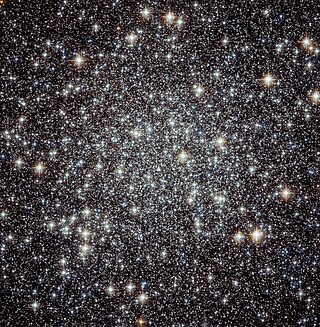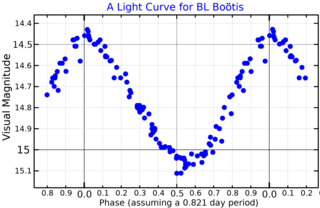Related Research Articles

Messier 13 or M13, also designated NGC 6205 and sometimes called the Great Globular Cluster in Hercules or the Hercules Globular Cluster, is a globular cluster of several hundred thousand stars in the constellation of Hercules.

Williamina Paton Stevens Fleming was a Scottish-American astronomer. She was a single mother, hired by the director of the Harvard College Observatory to help in the photographic classification of stellar spectra. She helped develop a common designation system for stars and cataloged more than ten thousand stars, 59 gaseous nebulae, over 310 variable stars, and 10 novae and other astronomical phenomena. Among several career achievements that advanced astronomy, Fleming is noted for her discovery of the Horsehead Nebula in 1888.

Messier 4 or M4 is a globular cluster in the constellation of Scorpius. It was discovered by Philippe Loys de Chéseaux in 1745 and catalogued by Charles Messier in 1764. It was the first globular cluster in which individual stars were resolved.

Helen Battles Sawyer Hogg was an American-Canadian astronomer who pioneered research into globular clusters and variable stars. She was the first female president of several astronomical organizations and a scientist when many universities would not award scientific degrees to women. Her scientific advocacy and journalism included astronomy columns in the Toronto Star and the Journal of the Royal Astronomical Society of Canada. She was considered a "great scientist and a gracious person" over a career of sixty years.

Messier 5 or M5 is a globular cluster in the constellation Serpens. It was discovered by Gottfried Kirch in 1702.

Messier 107 or M107, also known as NGC 6171, is a very loose globular cluster in a very mildly southern part of the sky close to the equator in Ophiuchus, and is the last such object in the Messier Catalogue.

The American Association of Variable Star Observers (AAVSO) is an international nonprofit organization. Founded in 1911, the organization focuses on coordinating, analyzing, publishing, and archiving variable star observations made largely by amateur astronomers. The AAVSO creates records that establish light curves depicting the variation in brightness of a star over time. The AAVSO makes these records available to professional astronomers, researchers, and educators.

Messier 3 is a globular cluster of stars in the northern constellation of Canes Venatici.

Messier 9 or M9 is a globular cluster in the constellation of Ophiuchus. It is positioned in the southern part of the constellation to the southwest of Eta Ophiuchi, and lies atop a dark cloud of dust designated Barnard 64. The cluster was discovered by French astronomer Charles Messier on June 3, 1764, who described it as a "nebula without stars". In 1783, English astronomer William Herschel was able to use his reflector to resolve individual stars within the cluster. He estimated the cluster to be 7–8′ in diameter with stars densely packed near the center.

Messier 15 or M15 is a globular cluster in the constellation Pegasus. It was discovered by Jean-Dominique Maraldi in 1746 and included in Charles Messier's catalogue of comet-like objects in 1764. At an estimated 12.5±1.3 billion years old, it is one of the oldest known globular clusters.

Messier 22 or M22, also known as NGC 6656, is an elliptical globular cluster of stars in the constellation Sagittarius, near the Galactic bulge region. It is one of the brightest globulars visible in the night sky. The brightest stars are 11th magnitude, with hundreds of stars bright enough to resolve with an 8" telescope. It is just south of the sun's position in mid-December, and northwest of Lambda Sagittarii, the northernmost star of the "Teapot" asterism.

Messier 28 or M28, also known as NGC 6626, is a globular cluster of stars in the center-west of Sagittarius. It was discovered by French astronomer Charles Messier in 1764. He briefly described it as a "nebula containing no star... round, seen with difficulty in 31⁄2-foot telescope; Diam 2′."

Messier 70 or M70, also known as NGC 6681, is a globular cluster of stars to be found in the south of Sagittarius. It was discovered by Charles Messier in 1780. The famous comet Hale–Bopp was discovered near this cluster in 1995.

Messier 71 is a globular cluster in the small northern constellation Sagitta. It was discovered by Philippe Loys de Chéseaux in 1745 and included by Charles Messier in his catalog of non-comet-like objects in 1780. It was also noted by Koehler at Dresden around 1775.

NGC 5466 is a class XII globular cluster in the constellation Boötes. Located 51,800 light years from Earth and 52,800 light years from the Galactic Center, it was discovered by William Herschel on May 17, 1784, as H VI.9. This globular cluster is unusual insofar as it contains a certain blue horizontal branch of stars, as well as being unusually metal poor like ordinary globular clusters. It is thought to be the source of a stellar stream discovered in 2006, called the 45 Degree Tidal Stream. This star stream is an approximately 1.4° wide star lane extending from Boötes to Ursa Major.

NGC 6934 is a globular cluster of stars in the northern constellation of Delphinus, about 52 kilolight-years distant from the Sun. It was discovered by the German-born astronomer William Herschel on 24 September 1785. The cluster is following a highly eccentric orbit through the Milky Way along an orbital plane that is inclined by 73° to the galactic plane. It may share a common dynamic origin with NGC 5466. As of 2018, it has been poorly studied.

NGC 6496 is a globular cluster which is in the direction of the Milky Way's galactic bulge based on observations collected with the WFPC2 on board the Hubble Space Telescope. NGC 6496 was originally believed to be a member of the disc system of the Galactic Center, but scientists questioned this classification. It was instead suggested that NGC 6496, together with two other clusters, NGC 6624 and NGC 6637, could be halo clusters with strongly inclined orbits. NGC 6496 lies in the Southern sky at RA=17:59:03.68 and Dec=-44:15:57.4.

BL Boötis is a pulsating star in the constellation Boötes. It is the prototype of a class of anomalous Cepheids which is intermediate in the H-R diagram between the type I classical Cepheids and the type II Cepheids.
William Liller was an American astronomer, known for his research on "planetary nebulae, comets, asteroids, magnetic activity in cool stars, the optical identification of X-ray sources, and astro-archaeology."

Alice Hall Farnsworth was an American astronomer. She was director of John Payson Williston Observatory at Mount Holyoke College from 1936 until her retirement in 1957.
References
- 1 2 3 4 5 6 7 8 9 10 11 12 13 14 15 Williams, Thomas R. ; Willson, Lee Anne (2007). "Obituary: Martha Locke Hazen, 1931-2006". Bulletin of the American Astronomical Society. 39 (4): 1064–1065. Bibcode:2007BAAS...39.1064W.
{{cite journal}}: CS1 maint: multiple names: authors list (link) - 1 2 3 4 5 6 7 8 9 10 "In Memoriam: Martha L. Hazen | aavso". www.aavso.org. Retrieved 2022-03-15.
- ↑ University of Michigan, Board of Regents (1957). Proceedings of the Board of Regents. p. 357.
- 1 2 3 "Martha Hazen Obituary from Center for Astrophysics | aavso". www.aavso.org. Retrieved 2022-03-15.
- ↑ "The Merit Award | aavso". www.aavso.org. Retrieved 2022-03-06.